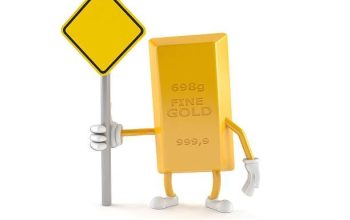A gold IRA is an investment account where you can buy physical gold or other precious metal coins. You can use it to diversify your portfolio, protect against inflation, and earn tax benefits.
There are two main types of accounts: self-directed and custodial. In a self-directed account, you choose what investments go into your account. In a custodial account, the provider holds the funds for you.
An investor must pay taxes on the gains he makes on his gold IRA. If you sell your gold, you’ll owe capital gains taxes on the profits. However, there are some exceptions to this rule. For example, if you’re selling your gold because it’s worth less than $5,000, you won’t owe any taxes.
If you want to open a gold IRA, you’ll need to do some research about how much money you can invest. Some providers allow you to put up to $50,000 per person, while others limit you to just $10,000.
Gold-backed IRA pros & cons

A gold-backed IRA is a great way for people to invest in precious metals without having to worry about the fluctuation of the market. However, there are some things to consider before opening one up.
Pros:
1. You don’t have to pay taxes on your gains.
2. Your money grows tax-free.
3. You can use it to buy anything.
4. You can withdraw it whenever you like.
5. You can roll over your account into another retirement plan.
Cons:
1. The price of gold may not be stable enough to make it worthwhile.
2. It’s hard to get started with a gold-backed IRA.
3. There aren’t many places that offer them.
4. They are expensive.
5. You might lose all your money.
Alternative investments to physical gold

Investors looking to diversify away from traditional stock market investments might consider buying into gold. While gold prices are volatile, some investors believe that owning physical gold is a good investment strategy. However, there are many different ways to invest in gold. Some people prefer to put money into exchange-traded funds (ETFs), while others like to buy shares of companies that produce gold. Still, others opt to purchase physical gold directly. In addition to ETFs, mutual funds are another popular option for those seeking exposure to gold. And finally, investors can use government securities such as Treasury bills and notes to gain access to gold.
Gold ETFs
An investor can invest in gold through ETFs, which trade on exchanges just like stocks do. These funds track the price of gold and automatically rebalance themselves based on changes in the spot price. They are designed to provide a steady stream of income over time. For example, the SPDR Gold Trust holds about $40 billion worth of gold bullion and is one of the largest gold ETFs. This fund provides investors with a reliable source of income and protects them from fluctuations in the value of gold.
Mutual Funds
Another popular choice among investors is a mutual fund. Mutual funds are similar to ETFs because they hold assets that track an index. But unlike ETFs, mutual funds allow you to pick exactly what type of asset you want to invest in. You can choose from a variety of sectors including energy, technology, precious metals, real estate and healthcare. There are even specialized funds focused on specific industries such as mining, agriculture and oil & gas. A mutual fund gives you flexibility and control over how much risk you take on.
Physical Gold
If you want to invest in physical gold, you can either go to a local coin shop and buy coins or bars, or you can sell unwanted jewelry online and make a profit. Another option is to find someone willing to pay cash for your gold. Then you can simply hand over the items and walk away without paying taxes. Buying physical gold is typically less expensive than buying ETFs or mutual funds.
How do I acquire physical gold?
If you’re looking to buy physical gold, you’ll want to know about the different types of gold available and where to find them. There are many ways to invest in gold including purchasing shares in a gold mining company, owning gold bullion bars, and even purchasing gold coins from the government mint. Although each option offers unique benefits, they do differ slightly. For example, some companies offer dividends while others don’t; some allow you to hold onto the gold for longer periods of time while others require immediate delivery.
The most popular way to buy gold is through a cash purchase. This allows you to avoid paying sales tax and avoids potential issues with taxation. However, you won’t benefit from the added protection of ownership. In addition, you’ll likely pay a premium over wholesale prices. You might think that you could save money by buying gold through a dealer because dealers typically charge less than retail stores. Unfortunately, this isn’t always true. Dealers often mark up the price of gold to cover costs such as storage fees, insurance, and shipping.
Buying gold through a dealer doesn’t guarantee that you’ll receive the best deal possible. Some dealers specialize in selling bulk quantities of gold. As a result, they may be able to negotiate better deals with suppliers. They also may be able to provide discounts on multiple purchases. On the flip side, some dealers sell small amounts of gold. Because they aren’t buying large volumes, they may not be able to obtain the same discounts.
You can also buy gold online directly from the manufacturer. Online retailers usually sell gold bullion bars and rounds. These items are generally stored in secure vaults and insured against theft. Additionally, some online sellers offer free shipping. This makes buying gold easier and faster than shopping locally.
When deciding whether to buy gold through a local retailer or online, consider the following factors:
• Price. Look for reputable dealers that offer competitive pricing.
• Location. Consider proximity to your home, office, or vacation spot.
• Reputation. Ask friends and family if they’ve had any experience with the dealer.
• Returns policy. Find out what happens if the item arrives damaged or defective.
• Customer service. Is customer support available 24/7? Do they have a return policy?
Is it a good idea to invest in gold?
If you are looking to diversify your portfolio, investing in physical gold could be a good idea. However, it does come with some drawbacks. If you choose to invest in physical gold, there are several things you must consider. First, you will have to build your own safe and install additional security devices. Second, you would incur expenses from building the safe and purchasing other security equipment. Third, you would have to deposit in a bullion bank to store your physical gold.
Fourth, selling physical gold is much more cumbersome than alternative options like gold ETFs. Finally, if you are interested in making passive income, gold is not a great investment option because it has had a terrible historical return. However, if you want to hedge against inflation, or if you just want to hold onto your wealth during a disaster, physical gold might be worth considering.
Some advantages of investing in physical gold
Inflation is one of the biggest concerns for investors today. If you’re worried about the future, gold might be a good investment option. Here are some advantages of investing in physical gold.
1. You Can’t Lose Your Money
You can lose your money in stocks, bonds, mutual funds, etc. But you cannot lose your money in gold. When you invest in gold, you buy something tangible. So even if there is a financial crisis, you won’t lose your money.
2. Price Will Never Go Down
The price of gold will always remain stable. This makes it a very reliable investment. As long as the world economy isn’t affected by a global recession, the price of gold will never fall.
3. Increases Value Over Time
When you purchase gold, it increases in value over time. For example, if you bought $10 worth of gold 20 years ago, it now costs around $40.That’s a 400% increase!
4. It’s A Good Hedge Against Inflation
Gold prices tend to rise when inflation rises. Because it is so expensive, people often use it as a way to protect themselves from rising prices.
5. It Has Been Around Forever
Gold has been used throughout history as currency. It was first used in ancient Egypt, Greece, China, India, and many others.
Some disadvantages of investing in physical gold
Investors must consider where they are keeping their gold before making any decisions about whether to invest in physical gold. Physical gold is not suitable if you want to build wealth over the long term. An allocated account is better than an unfunded one because it gives you security. Buying physical gold is very expensive and risky. You could lose all or part of your money in case of a major financial crisis. People often dislike investing in gold because it does not grow over time.
If you are looking to make money through investments, then you should look into different types of investments such as stocks, mutual funds, exchange-traded funds (ETF), and commodities. Each type of investment offers its own benefits and risks.
Stocks offer capital gains, but riskier returns. Mutual funds provide steady growth, but less control over the assets. Commodities offer higher profits, but also have greater volatility. Exchange-traded funds give you access to both worlds: high-profit potential with low risk.
For those who prefer to keep their money outside of the stock market, ETFs may be the best choice. They combine the liquidity of stocks with the diversification of commodities.
Should you buy physical gold or stocks?
Gold is one of the most popular investment vehicles, especially among those seeking safe haven investments during turbulent times. But is it really safer than investing in stocks? And what about the risk involved? We asked three experts for their take.
Investors looking for safety might want to consider buying physical gold rather than holding shares in companies. While gold is considered a safe bet because it doesn’t fluctuate much in price, there are risks associated with owning physical gold. For example, you could lose money if you sell it too early. You’ll also pay storage fees, and you won’t receive dividends as you do with stock shares.
But, according to David Kostin, managing director and head of quantitative strategy at Goldman Sachs Asset Management, “gold is actually a pretty good diversifier.” He says investors should look into the performance of different asset classes over long periods of time. If the S&P 500 outperforms gold, then he recommends purchasing stocks. However, if the reverse occurs, then he advises investors to invest in gold.
Physical gold or silver?
Silver is often considered a safe haven asset, while gold is seen as a hedge against inflation. However, there are many reasons why investing in either one could make sense for investors. Here are some pros and cons to consider when deciding whether to go with gold or silver.
Gold is a good choice for investors looking to protect themselves from inflation. Inflation erodes purchasing power, making it harder for people to afford things like food, clothing, shelter, education, and healthcare. This makes gold a useful store of value. Investors tend to prefer assets that retain their value, such as real estate, stocks, bonds, and cash. But what about those times when the stock market goes down? If you think the Dow Jones Industrial Average might drop 10% in a month, you’ll probably want to put money into something that won’t lose much value.
Physical gold is a good option because it doesn’t fluctuate based on investor sentiment. Unlike stocks, which are influenced by economic conditions, the price of gold tends to remain relatively stable. As a result, it’s less likely to fall during bear markets. On the flip side, though, gold prices do rise along with the overall economy. So, if you see signs of growth, you’ll likely see rising demand for gold.
If you want to invest in a metal that retains its value even when the economy does well, silver is a smart choice. Like gold, silver prices don’t move too much based on investor emotions. And unlike gold prices, silver prices tend to increase when the economy grows. For example, the average price of silver increased nearly 30% between 2001 and 2011. During the same period, the Dow Jones Industrial Average rose just 12%.
Physical Gold vs Paper Gold – What’s the difference?
Bullion bars or bullion coins are actual pieces of gold bars. They come in different sizes and weights. A bar of gold might weigh 5 ounces, while a coin weighs one ounce. Gold coins are minted by governments around the world. These coins are legal tender, meaning they’re accepted as payment within the borders of whatever country issues them.
Paper gold is an IOU or promissory note for gold. This type of gold is called “paper gold,” because it exists only as a promise to pay. There is no physical gold behind it. You cannot touch it, feel it, smell it, taste it or see it. It’s just a piece of paper.
The ratio of exchange is about 20 to 1. One ounce of gold equals $1,000. But one ounce of paper gold only equals about $20.The reason for this discrepancy is that the government charges banks a premium to accept paper gold as collateral. Banks charge these premiums because they know that the U.S. Treasury will redeem the paper gold for physical gold upon request.
When the U.S. government wants to borrow money, it sells paper gold. When the government pays back the loan, it buys more paper gold. This process continues until there is enough paper gold to repay the debt. The government has created over 16 million ounces of paper gold since 1971.
Frequently Asked Questions
How does a physical gold IRA work?
A physical gold IRA is an investment vehicle that allows you to own and store physical gold. You can buy, sell or trade your gold in the market without having to worry about its value fluctuating due to inflation. This means that if you want to invest in gold for retirement purposes, this type of account will be more stable than other types of investments such as stocks and bonds.
Can you physically hold gold in an IRA?
Yes, you can. You can also put it into a brokerage account or a bank CD. But if you want to be able to access your money quickly and easily, the best thing is to keep it in an IRA.
What are the pros and cons of a gold IRA?
Pros
You can invest in physical gold. You don’t have to worry about your investment being stolen or lost.
If you’re worried about inflation, then this is a good way to protect yourself from it. If you buy physical gold, you’ll be able to sell it at any time for whatever price you want.
It’s an easy way to diversify your portfolio.
Cons
There is a minimum amount of gold that must be held in order to open an IRA. In addition, you may not be allowed to purchase gold with cash.
It’s expensive to maintain. You need to make sure that you have enough funds available each month to cover the cost of buying and storing your gold.


